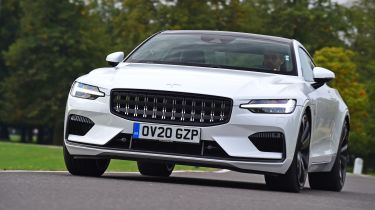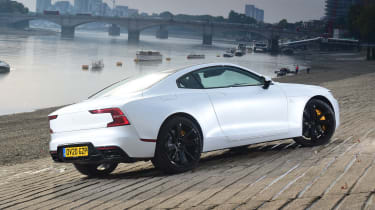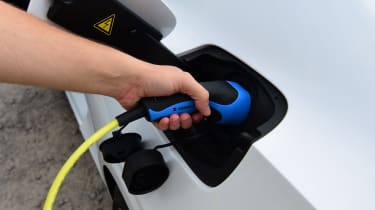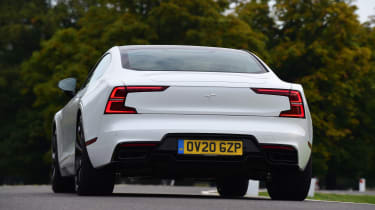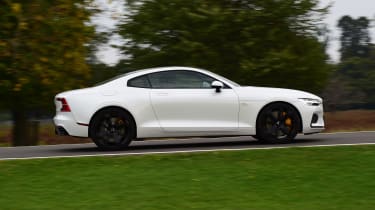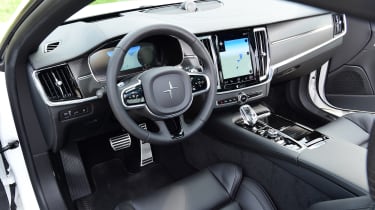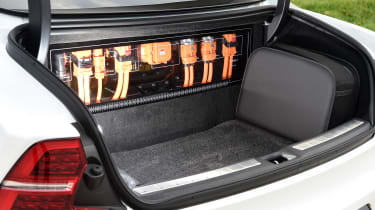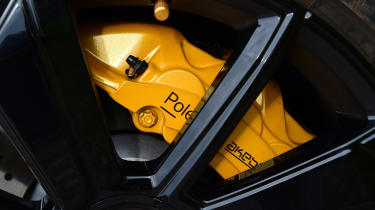Polestar 1 coupe review
"Left-hand drive and a limited production run mean the Polestar 1 is destined to be a rare collectible coupe that combines 601bhp with a 78-mile pure-electric range"
Pros
- Stunning design
- Exclusivity
- Clever powertrain
Cons
- Tiny boot
- Left-hand drive only
- Underwhelming interior
When Volvo created its sub-brand Polestar, it needed a first car that would make an impact, and the stunning Polestar 1 is the result. While most manufacturers are putting plug-in hybrid technology into SUVs, Polestar has come out of the gates with an attractive two-door coupe that looks truly special.
Glancing at the spec sheet, buyers’ hearts may sink at the realisation it only has a 2.0-litre petrol engine, but forced induction and a pair of electric motors on the rear axle mean its combined power is a heady 601bhp. The Polestar can get from 0-62mph in just over four seconds but even more staggering are its official economy figures of 470.8mpg and 13g/km of CO2, which are achieved thanks to a 77-mile electric-only range.
The Polestar 1’s petrol engine, two electric motors and 34kWh battery mean the car weighs well over two tonnes, but you wouldn't know it from behind the wheel. It might not be a hardcore trackday sports car to rival the Porsche 911, but it feels potent, agile and secure on the road, largely thanks to its manually adjustable Ohlins suspension.
It's a shame there are a few issues inside. Quality is excellent, the front seats are comfortable and everything works well enough, but the displays and even the steering wheel will be familiar to owners of much less expensive Volvos, which is a shame in a car that costs this much. As a 2+2 coupe, there's only enough space in the back for kids - an issue most rivals also face - and more crucially, the 143-litre boot is very limiting for a car that otherwise makes a great long-distance companion.
Crisp lines, along with the sheer road presence and rarity of the Polestar 1, should convince enough owners to forget its negatives, and it does excel in certain areas. However, for most buyers a more conventional coupe will make more sense, or even the more practical, even faster all-electric Porsche Taycan.
MPG, running costs & CO2
This is a new breed of sporting GT car; one whose eco-credentials are just as likely to come up in conversation as its 0-62mph time. It’s arguably the former that are the most impressive in the Polestar 1’s case because this plug-in hybrid has a 34kWh battery pack and electric motors that can propel it emissions-free for up to 77 miles.
That's easily enough range to cover the average motorist’s daily commute, and far exceeds the requirement for shutting the petrol engine off when you reach a busy town centre or your child's school. According to the WLTP fuel-efficiency tests, the Polestar 1 averages up to 470.8mpg and 13g/km of CO2 emissions, but in the real-world this will vary depending on how much you can charge the battery and travel on electric power alone.
Business drivers will save money thanks to a low Benefit-in-Kind (BiK) rate, while all buyers will pay £135 a year in road tax, after the first five years of paying £455 owing to the 1's high list price. Insurance is also likely to be expensive given the Polestar's cost and performance, but maintenance should be affordable for a car of its type - cars with regenerative braking tend to be a lot kinder to their brakes for a start, using the electric motors like a dynamo to slow down.
Engines, drive & performance
The Polestar 1 boasts an impressive 601bhp, making it more powerful than the Aston Martin Vantage and Porsche 911 Carrera S, yet its combustion engine is only a four-cylinder, 2.0-litre petrol engine. Thanks to a supercharger and turbocharger this can make up to 304bhp on its own, but it's joined in the fight by a pair of rear electric motors that add a healthy 228bhp and heaps of torque, which is delivered the instant you flex your right foot. Its power figure has already been surpassed by all-electric models like the Porsche Taycan Turbo S with 751bhp but it’s still far higher than existing plug-in hybrid rivals like the 369bhp BMW i8 and the Lexus LC500h with 354bhp.
One major pitfall of the Polestar 1's complex powertrain is weight, because even using a carbon-fibre-reinforced plastic (CFRP) structure, the car still weighs in at 2,350kg. A non-hybrid, Porsche 911 Carrera 4S is around 700kg lighter. Still, the Polestar's 1,000Nm of torque does a good job of hiding the bulk, feeling even faster than its 0-62mph time of 4.2-seconds suggests. The 1 races through the gears, and massive brakes quickly scrub off speed when required.
In its less aggressive driving modes, the Polestar also has enough electric regeneration to allow one-pedal driving, where the car will slow significantly when you come off the accelerator. The steering is accurate and there's always a sense of huge grip, while the rear electric motors can boost agility by sending more torque to the rear wheel on the outside of the corner. Each corner is fitted with a manually adjustable Ohlins damper, and we'd be tempted to soften them to enjoy the Polestar 1 as a rapid, comfortable, GT car. However, even in their standard setting, the ride feels more fluid the faster you go, and the Polestar makes an impressive cruiser despite its 21-inch alloy wheels.
Interior & comfort
After drinking in the wide, low-slung exterior, the interior can come as a bit of a disappointment. There's nothing fundamentally wrong but a lot of the dashboard and technology is familiar from the Volvo XC40, which costs a fraction of the Polestar's £140,000 asking price. This includes the digital instrument display, portrait central infotainment system and three-spoke steering wheel, which are starting to look their age.
On the plus side, quality is on par with rivals, and features such as hugging seats, frameless doors, a panoramic glass roof and the complete lack of B-pillars remind you this is the interior of something special. There are even some quirky touches like an illuminated Polestar logo that's designed to reflect in the glass roof like a star shining overhead. Other highlights include carbon trim across the dashboard and doors, a crystal gear lever and a Bowers and Wilkins stereo system. There doesn't appear to be many customisation options for the interior, other than to pick dark Charcoal or light Zinc seat upholstery.
Practicality & boot space
While weight is one issue for the Polestar 1, another is practicality. Given that the 1 feels more like a GT than an outright sports car, and that its plug-in hybrid powertrain means you can take long road trips without worrying about finding a public charger, its meagre 143-litre boot could be a serious hindrance.
The Porsche Taycan Turbo S is admittedly a bigger car, but it costs roughly the same (before options), has more power, four doors, a proper back seat and a 366-litre boot. Meanwhile, the BMW i8 reinforces the issues designers face packing a plug-in powertrain into a svelte coupe; it manages just 154 litres of luggage room. Like the i8, the inside of the Polestar 1 is also arranged in a 2+2 layout, with rear seats that can accommodate small children or a few bags of shopping but have restrictive knee room for adults.
Reliability & safety
This might be the first-ever Polestar model but it's based on Volvo engineering and technology. That's sure to reassure buyers because the Swedish manufacturer has a good reputation for building tough, reliable cars and a great reputation for safety.
In fact, the starting point of the 2.0-litre engine is shared with numerous Volvo models, and the same goes for many of the 1's electronics. Of course, much of the Polestar is new, and while it looks to have been painstakingly engineered, reliability will be unknown for several years. Safety isn’t a concern because not only is the 1's CFRP body extremely stiff, the car is also fitted with all the latest safety technology from parent company Volvo.

